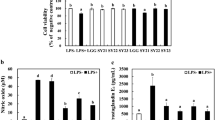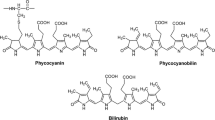Abstract
The anti-inflammatory effects of mung bean protein hydrolysate (MBPH) on the lipopolysaccharide (LPS)-induced macrophages were investigated herein. MBPH was shown to affect the cell morphology, proliferation, cell cycle, cytokine levels at different culture times, and the expression level of nuclear factor-kappa B (NF-κB). The obtained results revealed that different fractions of MBPH promote cell proliferation, alter the cell cycle by decreasing the proportion of cells in the S stage and increasing the proportion of cells in the G2 stage, increase the expression of cytokines, included IL-6, IL-1β, and TNF-α, and negatively affect the LPS-induced inflammatory cytokines. Based on the analysis of cytokine expression at different points in time, it is concluded that cytokine secretion of MBPH-treated group reaches a peak at 24 h, the result was significantly different compared to other treatment groups (P < 0.05). It can be observed that the inflammatory response induced by LPS in the MBPH-III treatment group is reduced compared with other fractions (P < 0.05). In addition, MBPH inhibits the activation of NF-κB signaling pathway by inhibiting the nuclear transcription of p65 and phosphorylation of IκBα in macrophages induced by LPS. Our results demonstrated that lower molecular weight MBPH exerted stronger anti-inflammatory effects than other molecular fractions. Thus, MBPH could be utilized as a functional food ingredient to prevent inflammation in chronic diseases.






Similar content being viewed by others
Abbreviations
- LPS:
-
Lipopolysaccharide
- NF-κB:
-
Nuclear factor kappa-B
- MBPH:
-
Mung bean protein hydrolysate
- IL-6:
-
Interleukin-6
- IL-1β:
-
Interleukin-1β
- TNF-α:
-
Tumor necrosis factor-α
References
Chalamaiah M, Yu WL, Wu JP. Immunomodulatory and anticancer protein hydrolysates (peptides) from food proteins: A review. Food Chemistry. 245:205-222 (2018)
Chen MX, Zheng SX, Yang YN, Xu C, Liu JS, Yang WD. Strong seed-specific protein expression from the vigna radiata storage protein 8sgα promoter in transgenic arabidopsis seeds. Journal of Biotechnology. 174:49-56 (2014)
Cian RE, Posadas RL, Drago SR, Medina FS, Olga MA. A Porphyra columbina hydrolysate upregulates IL-10 production in rat macrophages and lymphocytes through an NF-κB, and p38 and JNK dependent mechanism. Food Chemistry. 134:1982-1990 (2012)
Diao JJ, Chi ZP, Guo ZW, Zhang LP. Mung bean protein hydrolysate modulates the immune response through NF-κB pathway in lipopolysaccharide-Stimulated RAW264.7 macrophages. Journal of Food Science. 84:2652-2657 (2019)
Diao JJ, Zhang LP. Separation and purification of stronger antioxidant peptides from pea protein. Journal of Chinese Institute of Food Science and Technology. 14:133-141 (2014)
Hou H, Fan Y, Li B, Xue C, Yu G, Zhang Z. Purification and identification of immunomodulating peptides from enzymatic hydrolysates of Alaska pollock frame. Food Chemistry. 134:821-828 (2012)
Keong YS, Kee BB, Yong HW, Hamidah MY, Elyani MN, Mohd AN. In vivo antioxidant and hypolipidemic effects of fermented mung bean on hypercholesterolemic mice. Evidence-Based Complementary and Alternative Medicine. 2015:1-6 (2015)
Kong XZ, Guo MM, Hua YF, Cao D, Zhang CM. Enzymatic preparation of immunomodulating hydrolysates from soy proteins. Bioresource Technology. 18:8873-8879 (2008)
Li HS, Gao CC, Xie WT, Xu CH. Effects of soybean peptide on immune function in mice. Guangdong Agricultural Sciences. 39:109-111 (2012)
Liyanage R, Kiramage C, Visvanathan R, Jayathilake C, Vidanarachchi J. Hypolipidemic and hypoglycemic potential of raw, boiled, and sprouted mung beans (Vigna radiata L. Wilczek) in rats. Journal of Food Biochemistry. 42(1):1-6 (2017)
Liu Y, Li JM, Tan T, Jiang Y. Progress of cell penetrating peptides application as delivery agent. Progress in Biochemistry and Biophysics. 41:731-738 (2014)
Lu W. Antimicrobial peptides. Seminars in Cell & Developmental Biology. 77:1-2 (2018)
Mendoza EMT, Adachi M, Bernardo AEN, Utsumi S. Mungbean [Vigna radiata (L.) Wilczek] globulins: purification and characterization. Journal of Agricultural and Food Chemistry 49:1552-1558 (2001)
Nair RM, Thavarajah D, Thavarajah P, Giri RR, Jdh K. Mineral and phenolic concentrations of mungbean [Vigna radiata (L.) R. wilczek var. radiata] grown in semi-arid tropical india. Journal of Food Composition and Analysis. 39:23-32 (2015)
Nakayama K, Hirata TS, Okamoto K, Morotomi T, Jimi E, Kitamura C. The novel NF-κB inhibitor, MTI-II peptide anti-inflammatory drug, suppresses inflammatory responses in odontoblast-like cells. Journal of Cellular Biochemistry. 9999:1-7 (2016)
Olszewski W, Darzynkiewicz Z, Rosen PP, Schwartz MK, Melamed MR. Flow cytometry of breast carcinoma: II. Relation of tumor cell cycle distribution to histology and estrogen receptor. Cancer. 48:985-988 (2015)
Petrov RV, Mikhailova AA, Fonina LA. Bone marrow immunoregulatory peptides (myelopeptides): isolation, structure, and functional activity. Peptide Science. 43:139-146 (2015)
Ren WZ. A Study of the bidirectional immunomodulatory effects of trametes versicolor polysaccharopeptide(PSP) on mouse macrophage and its regulation on NF-κB signal pathway. MS thesis, Shanghai Normal University, Shanghai, China (2010)
Sonklin C, Laohakunjit N, Kerdchoechuen O. Assessment of antioxidant properties of membrane ultrafiltration peptides from mung bean meal protein hydrolysates. PeerJ. 6:1-20 (2018)
Wang LL. Regulation of heat-killed lactobacillus body on RAW 264.7 cell inflammation. MS thesis, Harbin Institute fo Technology, Harbin, China (2016)
Wang P, Wang MS, Li CL, Li F, Wang J, Li XQ. Isolation, purification and structural identification of immunoactive peptides derived from hazelnut (Corylus heterophylla Fisch.) protein. Food Science. 39:200-205 (2018)
Wu GJ, Wu CH, Tsai GJ. Chitooligosaccharides from the shrimp chitosan hydrolysate induces differentiation of murine RAW264.7 macrophages into dendritic-like cells. Journal of Functional Foods. 12:70-79 (2015)
Wu JP, Pan WB. A review on biological active peptides derived from milk protein. China Dairy Industry. 27:12-15 (1999)
Yathisha U, Ishani B, Iddya K, Mamatha B. Antihypertensive activity of fish protein hydrolysates and its peptides. Critical Reviews in Food Science and Nutrition. 15:01-41 (2018)
Ye L, Yan J, Zhang W. Immunomodulatory effects of Meretrix meretrix oligopeptides on RAW264.7 cells. Journal of Fisheries of China. 43:24-32 (2019)
Zeng XB, Wang HY, Lin YC. Bioactive peptides in food: bioactivity and research progress. Science and Technology of Food Industry. 25:151-155 (2004)
Zheng X. The study of immunological activity of polysaccharides extracted from Anoectochilus formosanus on murine splenic lymphocytes and macrophage RAW246.7 cells in vitro. MS thesis, Fujian Agriculture and Forestry University, Fujian, China (2015)
Zhu YS, Sun S, Richard FG. Mung bean proteins and peptides: nutritional, functional and bioactive properties. Food & Nutrition Research. 62:1-11 (2018)
Acknowledgements
This work was supported by the Heilongjiang Major Science and Technology Projects (2021ZX12B06), National Program on Key Research Project (2018YFE0206300), and Heilongjiang Postdoctoral Fund (LBH-Z20206).
Author information
Authors and Affiliations
Contributions
JJD and XM designed the study, interpreted the results and drafted the manuscript. HSCh collected the test data and modified the manuscript.
Corresponding author
Ethics declarations
Conflict of interest
The authors declare that they have no conflict of interest.
Additional information
Publisher's Note
Springer Nature remains neutral with regard to jurisdictional claims in published maps and institutional affiliations.
Rights and permissions
About this article
Cite this article
Diao, J., Miao, X. & Chen, H. Anti-inflammatory effects of mung bean protein hydrolysate on the lipopolysaccharide- induced RAW264.7 macrophages. Food Sci Biotechnol 31, 849–856 (2022). https://doi.org/10.1007/s10068-022-01104-0
Received:
Revised:
Accepted:
Published:
Issue Date:
DOI: https://doi.org/10.1007/s10068-022-01104-0




